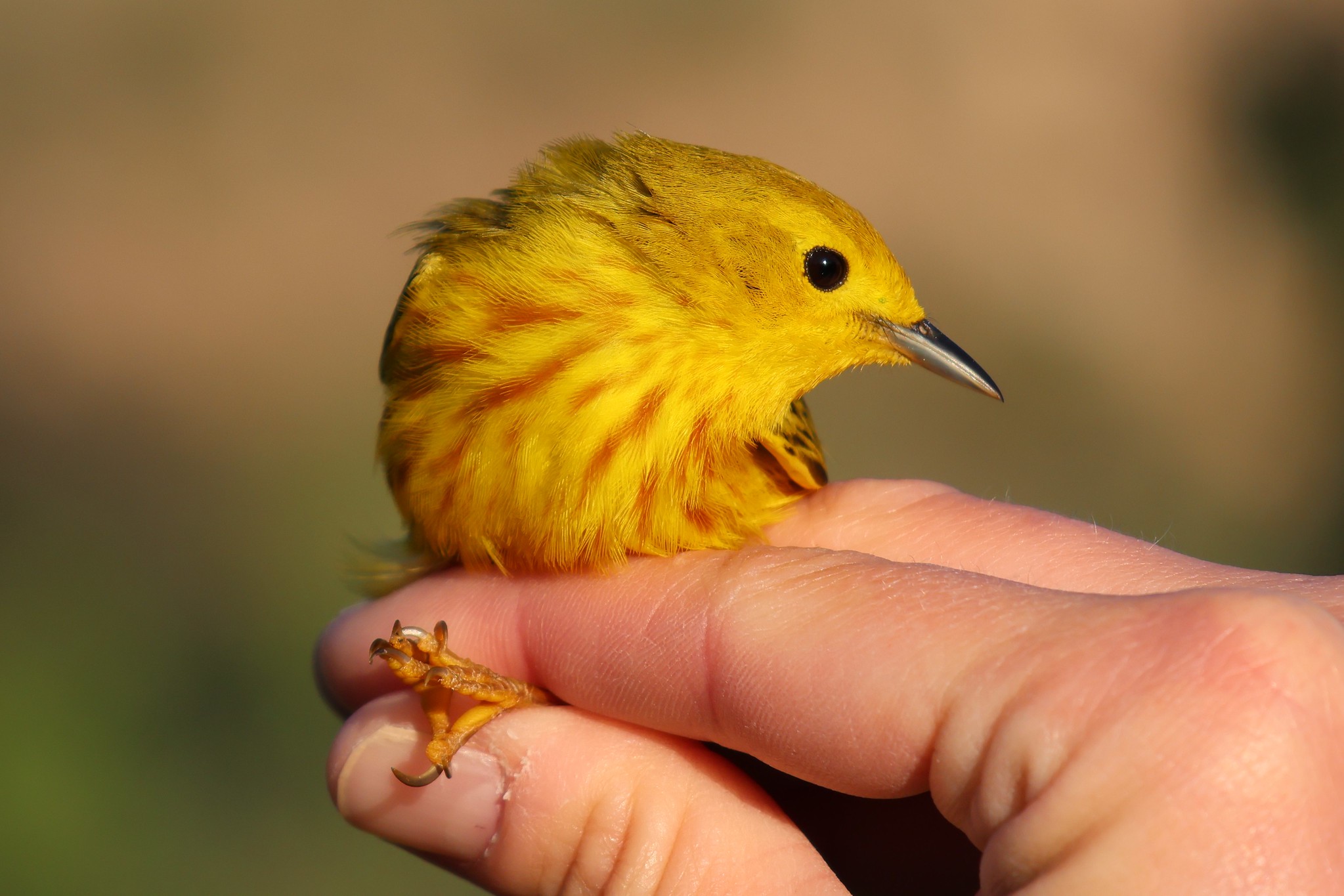Bird populations have been declining for decades, with three billion birds lost over the last 50 years. Understanding the drivers of these loses is a monumental task because most bird species have ranges that span large expanses across a mosaic of land uses.
What do Mexican Spotted Owls tell us about restoring frequent-fire regimes in the southwestern U.S.? Well, quite a lot actually.

Visit our Bird Banding Station located at Pineridge Natural Area this spring! Migration is a magical time of year! Come enjoy a unique opportunity to experience science in action and observe a wildlife biologist banding and collecting important scientific data on live, migrating birds. The data collected gives us insight to many aspects of avian life history and can be used to inform conservation decisions.
The Pineridge Banding Station is open from April 27th – May 30th, 2024.
One hour programs are available Tuesday – Friday from 7:30-8:30 a.m. and Saturdays from 7:30-8:30 a.m. and 8:30 – 9:30 a.m. (closed Sunday & Mondays).
The programs are provided at no cost, but registration is required!
Schedule is weather permitting. Station is closed during precipitation or high winds, and may close early during very hot weather and open later if very cold. Parking closest to the Banding Station is at Maxwell Natural Area (3502 CR 42C Fort Collins, CO). From there, access to the Station requires a very short walk across a road, then down and up a small hill on a packed dirt trail. Please note, this location is not easily wheelchair accessible.
Please note: Please check the website below for up to date closures of Pineridge Natural Area. If Pineridge Natural Area is closed, the banding station is closed as well.
https://www.fcgov.com/naturalareas/status
For more information: Sarah Doxon at (303) 659-4348 x 53 or [email protected]

Visit our Bird Banding Station located at Pineridge Natural Area this spring! Migration is a magical time of year! Come enjoy a unique opportunity to experience science in action and observe a wildlife biologist banding and collecting important scientific data on live, migrating birds. The data collected gives us insight to many aspects of avian life history and can be used to inform conservation decisions.
The Pineridge Banding Station is open from April 27th – May 30th, 2024.
One hour programs are available Tuesday – Friday from 7:30-8:30 a.m. and Saturdays from 7:30-8:30 a.m. and 8:30 – 9:30 a.m. (closed Sunday & Mondays).
The programs are provided at no cost, but registration is required!
Schedule is weather permitting. Station is closed during precipitation or high winds, and may close early during very hot weather and open later if very cold. Parking closest to the Banding Station is at Maxwell Natural Area (3502 CR 42C Fort Collins, CO). From there, access to the Station requires a very short walk across a road, then down and up a small hill on a packed dirt trail. Please note, this location is not easily wheelchair accessible.
Please note: Please check the website below for up to date closures of Pineridge Natural Area. If Pineridge Natural Area is closed, the banding station is closed as well.
https://www.fcgov.com/naturalareas/status
For more information: Sarah Doxon at (303) 659-4348 x 53 or [email protected]

Visit our Bird Banding Station located at Pineridge Natural Area this spring! Migration is a magical time of year! Come enjoy a unique opportunity to experience science in action and observe a wildlife biologist banding and collecting important scientific data on live, migrating birds. The data collected gives us insight to many aspects of avian life history and can be used to inform conservation decisions.
The Pineridge Banding Station is open from April 27th – May 30th, 2024.
One hour programs are available Tuesday – Friday from 7:30-8:30 a.m. and Saturdays from 7:30-8:30 a.m. and 8:30 – 9:30 a.m. (closed Sunday & Mondays).
The programs are provided at no cost, but registration is required!
Schedule is weather permitting. Station is closed during precipitation or high winds, and may close early during very hot weather and open later if very cold. Parking closest to the Banding Station is at Maxwell Natural Area (3502 CR 42C Fort Collins, CO). From there, access to the Station requires a very short walk across a road, then down and up a small hill on a packed dirt trail. Please note, this location is not easily wheelchair accessible.
Please note: Please check the website below for up to date closures of Pineridge Natural Area. If Pineridge Natural Area is closed, the banding station is closed as well.
https://www.fcgov.com/naturalareas/status
For more information: Sarah Doxon at (303) 659-4348 x 53 or [email protected]

Visit our Bird Banding Station located at Pineridge Natural Area this spring! Migration is a magical time of year! Come enjoy a unique opportunity to experience science in action and observe a wildlife biologist banding and collecting important scientific data on live, migrating birds. The data collected gives us insight to many aspects of avian life history and can be used to inform conservation decisions.
The Pineridge Banding Station is open from April 27th – May 30th, 2024.
One hour programs are available Tuesday – Friday from 7:30-8:30 a.m. and Saturdays from 7:30-8:30 a.m. and 8:30 – 9:30 a.m. (closed Sunday & Mondays).
The programs are provided at no cost, but registration is required!
Schedule is weather permitting. Station is closed during precipitation or high winds, and may close early during very hot weather and open later if very cold. Parking closest to the Banding Station is at Maxwell Natural Area (3502 CR 42C Fort Collins, CO). From there, access to the Station requires a very short walk across a road, then down and up a small hill on a packed dirt trail. Please note, this location is not easily wheelchair accessible.
Please note: Please check the website below for up to date closures of Pineridge Natural Area. If Pineridge Natural Area is closed, the banding station is closed as well.
https://www.fcgov.com/naturalareas/status
For more information: Sarah Doxon at (303) 659-4348 x 53 or [email protected]

Visit our Bird Banding Station located at Pineridge Natural Area this spring! Migration is a magical time of year! Come enjoy a unique opportunity to experience science in action and observe a wildlife biologist banding and collecting important scientific data on live, migrating birds. The data collected gives us insight to many aspects of avian life history and can be used to inform conservation decisions.
The Pineridge Banding Station is open from April 27th – May 30th, 2024.
One hour programs are available Tuesday – Friday from 7:30-8:30 a.m. and Saturdays from 7:30-8:30 a.m. and 8:30 – 9:30 a.m. (closed Sunday & Mondays).
The programs are provided at no cost, but registration is required!
Schedule is weather permitting. Station is closed during precipitation or high winds, and may close early during very hot weather and open later if very cold. Parking closest to the Banding Station is at Maxwell Natural Area (3502 CR 42C Fort Collins, CO). From there, access to the Station requires a very short walk across a road, then down and up a small hill on a packed dirt trail. Please note, this location is not easily wheelchair accessible.
Please note: Please check the website below for up to date closures of Pineridge Natural Area. If Pineridge Natural Area is closed, the banding station is closed as well.
https://www.fcgov.com/naturalareas/status
For more information: Sarah Doxon at (303) 659-4348 x 53 or [email protected]

Visit our Bird Banding Station located at Pineridge Natural Area this fall for an up close and personal experience with birds! You will have a unique opportunity to experience science in action and observe a wildlife biologist banding and collecting important scientific data on live, migrating birds. You will also learn about specialized bird adaptations and behavior, annual migration, crucial habitat requirements, and key conservation issues. Bird banding data increases our knowledge and understanding of birds and is often utilized in management and conservation projects!
The Pineridge Banding Station is open from September 8th – October 6th, 2023.
One hour programs are available Tuesday – Friday from 7:30-8:30 a.m. and Saturdays from 7:30-8:30 a.m. and 8:30 – 9:30 a.m. (closed Sunday & Mondays).
The programs are provided at no cost, but registration is required!
Schedule is weather permitting. Station is closed during precipitation or high winds, and may close early during very hot weather and open later if very cold. Parking closest to the Banding Station is at Maxwell Natural Area (3502 CR 42C Fort Collins, CO). From there, access to the Station requires a very short walk across a road, then down and up a small hill on a packed dirt trail. Please note, this location is not easily wheelchair accessible.
Please note: Please check the website below for up to date closures of Pineridge Natural Area. If Pineridge Natural Area is closed, the banding station is closed as well.
https://www.fcgov.com/naturalareas/status
For more information: Sarah Doxon at (303) 659-4348 x 53 or [email protected]
Have you ever wondered how bird conservation is coordinated across organizations and spatial scales? OK, maybe not, but imagine for a moment if it wasn’t. At all. Do you think there would be any hope of recovering populations and saving the hundreds of species that are spiraling towards extinction?
My journey toward a love for birds began in Central America during my Peace Corps years in Guatemala. Working as a volunteer, I was tasked with cataloging all bird species in a newly designated wildlife refuge and sprawling freshwater lowland jungle called Bocas Del Polochic. Working with local rangers hired to protect the refuge, we roamed the area via dugout canoe documenting the vast assemblage of different bird species.



